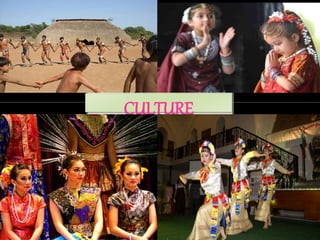
Culture power point
- 1. CULTURE
- 3. Interest in Fine Arts - Art lover - Art Admirer - Patron of the Arts - Enjoys everything in art >Painting to sculpture >Ballet to classical music >Artifacts to modern architecture CULTURE TOTHE LAYMAN
- 4. Being Civilized (Cultured) >Truly educated person - behavior shows refinement, - grace - sophistication >Uncultured shows: -Backward -Primitive -Illiterate CULTURE TOTHE LAYMAN Note: this term is not sociologically accepted. Countries which used to be called illiterate are now called Developing society
- 6. Culture is derived from the Latin word “cultura” or “cultus” which means care or cultivation. Culture as care: The fact that the human infant has a prolonged dependency, he has to be taken care of by the people around him. He has to learn from them so he can better adjust as he grows up in his immediate cultural environment. Culture as cultivation: Every human being is a potential member of his own social group. He is endowed with certain innate qualities like intelligence, creativity, resourcefulness. However, he cannot develop these inborn talents by himself alone. He needs other people who can provide him with the needed opportunities so he can translate these potentialities into realities called achievements.
- 7. The classical definition of culture was given by Sir Edward Taylor, an English anthropologist, who wrote “ Culture is that complex whole which includes knowledge, belief, art morals, law, custom, and any other capabilities and habits acquired by man as a member of society.” Complex whole, since it is concerned with the people’s life which is broad in itself. Touching on the multifarious aspects of life from conception to death, culture has a far reaching effect. One sociologist expressed this as: “ culture really affects a person from womb to tomb.” He also define culture as something acquired by man as a member of society. No society can exist without culture and vice versa. CLASSICALDEFINITIONOF CULTURE
- 8. • Joseph H. Fitcher gave more importance on culture than on society. He wrote “ Aperson may scape society for a while, but he can never scape culture. Even in isolation, where the person tries to get away from his social group temporarily, he thinks and acts according to the patterns of behavior with which he grew up.
- 9. • Culture as a Social Heritage Culture as a social heritage has two complication * it is complex * it is socially transmitted -Culture must be passed from one generation to another. • Culture as a distinguishing factor -Any society possesses its own culture which is more or less unique • Culture as an established pattern of behavior -Through culture, individuals within a social group can interact with one another • Culture as both material and immaterial * Material Lundberg, Schrag, and Larsen elucidated this point as: “ An ordinary piece of ground * Immaterial It is composed of the behavior, thoughts, beliefs, feelings as well as the intellectual, artistic, and social ideals and values that the members of the society profess and to which they strive to conform. PERTINENT MEANING OF CULTURE
- 11. (1) Culture is social: Culture does not exist in isolation. It is a product of society. It develops through social interaction. No man can acquire culture without association with others. Man becomes a man only among men. (2) Culture is shared: Culture is not something that an individual alone can possess. Culture in sociological sense is shared. For example, customs, traditions, beliefs, ideas, values, morale etc. are all shared by people of a group or society.
- 12. (3) Culture is learnt: Culture is not inborn. It is learnt. Culture is often called "learned ways of behavior". Unlearned behavior is not culture. But shaking hands, saying thanks' dressing etc. are cultural behavior. Namaskar: To greet another person a friend or acquaintance, to pay respect to an elder, a holy person or a temple deity or a Hindu joins his or her hands with palms together, bows down in front of the other person, and says Namaskar, Namaste, or Pranam - meaning Reverent Salutations.
- 13. (4) Culture is transmissive: Culture is transmissive as it is transmitted from one generation to another. Language is the main vehicle of culture. Language in different form makes it possible for the present generation to understand the achievement of earlier generations. Transmission of culture may take place by imitation as well as by instruction.
- 14. (5) Culture is continuous and cumulative: Culture exists as a continuous process. In its historical growth it tends to become cumulative. Sociologist Linton called culture 'the social heritage' of man. It becomes difficult for us to imagine what society would be like without culture.
- 15. (6) Culture varies from society to society: Every society has a culture of its own. It differs from society to society. Culture of every society is unique to itself. Cultures are not uniform. Cultural elements like customs, traditions, morale, values, beliefs are not uniform everywhere. Culture varies from time to time also.
- 16. (8) Culture is gratifying: Culture provides proper opportunities for the satisfaction of our needs and desires. Our needs both biological and social are fulfilled in the cultural ways. Culture determines and guides various activities of man. Thus, culture is defined as the process through which human beings satisfy their wants. (7) Culture is dynamic: No culture ever remains constant or changeless. It is subject to slow but constant change. Culture is responsive to the changing conditions of the physical world. Hence culture is dynamic.
- 17. CONCLUSION From the above discussion we are clear that each and every society has a culture of its own. Culture is not only diverse but also unequal, but is found in societies throughout the world.
